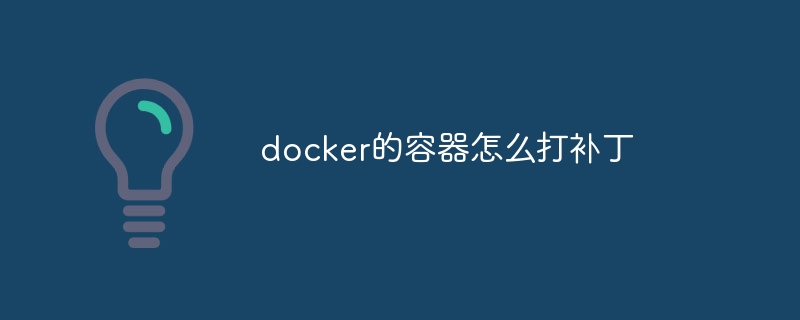How to patch docker containers
Several ways to patch Docker containers are: using official repository images, creating your own images and manually patching, and using patch management tools. Specific steps include: identifying containers that need to be patched, pulling patch images, replacing affected containers, and verifying patches.

Docker container patching
Docker containers are a lightweight virtualization environment that helps developers and system administrators deploy and manage applications quickly and consistently. To maintain the safety and stability of the container, it is crucial to patch the container regularly.
How to patch Docker containers
There are several ways to patch Docker containers:
1. Use Docker official repository image
The official repository image is maintained by Docker and is regularly updated with security patches. You can find the official image on [Docker Hub](https://hub.docker.com).
<code class="shell">docker pull your-image:latest</code>
2. Create your own image and patch it manually
You can create your own Docker image and include the necessary patches in it. Use the RUN directive to install patches during the image build process.
<code class="dockerfile">FROM base-image RUN apt-get update && apt-get install -y patch-package</code>
3. Use the patch management tool
There are many third-party tools that can help you automatically manage container patches. For example:
- [Anchore Enterprise](https://anchore.com/products/enterprise)
- [Twistlock](https://twistlock.com/)
- [Aqua Security](https://www.aquasec.com/)
Specific steps
1. Identify containers that require patches
Use the following command to scan the container for known vulnerabilities:
<code class="shell">docker scan --list</code>
2. Pull the patch image
Use the official repository or your own image to pull the latest image containing the patch.
3. Replace the affected container
Delete the affected container and recreate it, using a mirror with a patch.
<code class="shell">docker stop your-container docker rm your-container docker run -d --name your-container your-image:latest</code>
4. Verify patch
Use the following command to verify that the container has been successfully patched:
<code class="shell">docker inspect your-container | grep "Security"</code>
The above is the detailed content of How to patch docker containers. For more information, please follow other related articles on the PHP Chinese website!

Hot AI Tools

Undresser.AI Undress
AI-powered app for creating realistic nude photos

AI Clothes Remover
Online AI tool for removing clothes from photos.

Undress AI Tool
Undress images for free

Clothoff.io
AI clothes remover

Video Face Swap
Swap faces in any video effortlessly with our completely free AI face swap tool!

Hot Article

Hot Tools

Notepad++7.3.1
Easy-to-use and free code editor

SublimeText3 Chinese version
Chinese version, very easy to use

Zend Studio 13.0.1
Powerful PHP integrated development environment

Dreamweaver CS6
Visual web development tools

SublimeText3 Mac version
God-level code editing software (SublimeText3)

Hot Topics
 How to exit the container by docker
Apr 15, 2025 pm 12:15 PM
How to exit the container by docker
Apr 15, 2025 pm 12:15 PM
Four ways to exit Docker container: Use Ctrl D in the container terminal Enter exit command in the container terminal Use docker stop <container_name> Command Use docker kill <container_name> command in the host terminal (force exit)
 How to copy files in docker to outside
Apr 15, 2025 pm 12:12 PM
How to copy files in docker to outside
Apr 15, 2025 pm 12:12 PM
Methods for copying files to external hosts in Docker: Use the docker cp command: Execute docker cp [Options] <Container Path> <Host Path>. Using data volumes: Create a directory on the host, and use the -v parameter to mount the directory into the container when creating the container to achieve bidirectional file synchronization.
 How to restart docker
Apr 15, 2025 pm 12:06 PM
How to restart docker
Apr 15, 2025 pm 12:06 PM
How to restart the Docker container: get the container ID (docker ps); stop the container (docker stop <container_id>); start the container (docker start <container_id>); verify that the restart is successful (docker ps). Other methods: Docker Compose (docker-compose restart) or Docker API (see Docker documentation).
 How to check the name of the docker container
Apr 15, 2025 pm 12:21 PM
How to check the name of the docker container
Apr 15, 2025 pm 12:21 PM
You can query the Docker container name by following the steps: List all containers (docker ps). Filter the container list (using the grep command). Gets the container name (located in the "NAMES" column).
 How to start containers by docker
Apr 15, 2025 pm 12:27 PM
How to start containers by docker
Apr 15, 2025 pm 12:27 PM
Docker container startup steps: Pull the container image: Run "docker pull [mirror name]". Create a container: Use "docker create [options] [mirror name] [commands and parameters]". Start the container: Execute "docker start [Container name or ID]". Check container status: Verify that the container is running with "docker ps".
 How to start mysql by docker
Apr 15, 2025 pm 12:09 PM
How to start mysql by docker
Apr 15, 2025 pm 12:09 PM
The process of starting MySQL in Docker consists of the following steps: Pull the MySQL image to create and start the container, set the root user password, and map the port verification connection Create the database and the user grants all permissions to the database
 How to update the image of docker
Apr 15, 2025 pm 12:03 PM
How to update the image of docker
Apr 15, 2025 pm 12:03 PM
The steps to update a Docker image are as follows: Pull the latest image tag New image Delete the old image for a specific tag (optional) Restart the container (if needed)
 How to create containers for docker
Apr 15, 2025 pm 12:18 PM
How to create containers for docker
Apr 15, 2025 pm 12:18 PM
Create a container in Docker: 1. Pull the image: docker pull [mirror name] 2. Create a container: docker run [Options] [mirror name] [Command] 3. Start the container: docker start [Container name]






